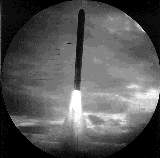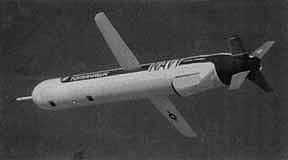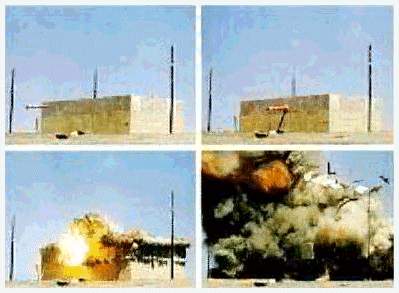 |
 |
 |
|
| A
Tomahawk Launch From USS Salt Lake City (SSN 716)
By STSCS(SS) J. Lund |
The green smoke was still visible in the distance, as another "whump" from the signal ejector shook the ship. Another smoke grenade bubbled to the surface of the water signaling one minute to time of launch.
"Green smoke on this bearing, mark!" said the captain, CDR Bill French, as he swung the periscope through the stern and towards the bow.
The seas were remarkably calm. A voice in the background announced, "thirty seconds to time of launch." Another visual "sweep" with the periscope confirmed the launch area was clear of interfering ships and aircraft. Constant radio communications with a nearby Coast Guard cutter and circling "chase" planes helped verify the area was a "go" for the launch of a Tomahawk cruise missile.
This particular Tomahawk missile was special. It represented a triumphant achievement for the officers and crew of the USS Salt Lake City (SSN 716) in completing the final phase of a combined Nuclear Weapons Regeneration exercise and Exercise GLOBAL GUARDIAN 98, a joint Navy and Air Force exercise. This was the first time a dual certification of two 688 class submarines (one on each coast) to employ nuclear weapons had been attempted.
The "regeneration" period that proceeded the launch involved intense shipwide training centered on the special security and safety requirements for nuclear weapons. USS Salt Lake City successfully completed the "regeneration" and was now conducting an operational test launch of a Tomahawk missile.
"Tee minus twenty seconds to launch," announced LTJG Greg Mingo, the officer designated to ensure the ship launched the Tomahawk missile at exactly the correct time.
Operators watched their displays closely for any indication of a missile or launching system malfunction. There were none. "Fifteen, fourteen...Standby!" ordered LT Mike Lewis, the ship's combat systems officer. Fire Control Petty Officer First Class James Henman placed the weapons launch firing key in the "standby" position. A series of relays shifted position, computer driven logic gates provided indications at the weapons launch console that all systems were "go" and the missile's rocket booster was armed.
Overhead, two "chase planes," Navy jet fighters, circled. The pilot's mission was to "chase" the missile during its flight and provide status reports of the missile's flight to personnel located ashore. Streams of bright green smoke could still be seen rising from the surface of the water. Pilots of the chase planes could not see the submarine below but knew her approximate position from the green smoke trail left in her wake. The last smoke device indicated one minute to launch and the pilots maneuvered their planes out of the missile's ascent path. The periscopes were carefully trained on the bearing where the missile would break the water's surface.
"Eleven, ten, nine...Shoot!" was ordered by the combat systems officer a full nine seconds before time zero. This timing allowed the missile to leave the torpedo tube exactly on the mark of zero. The weapons launch operator shifted the firing key to the FIRE position sending an electronic launch signal to the submarine's weapons system.
"Eight, seven, six, five, four, three, two, one, zero." Air valves hissed open, porting high pressure air to move a water ram which ejected the 3,000 pound missile out of the torpedo tube. "Booster ignition!" announced the sonar supervisor to the captain in the control room. The missile's solid rocket booster ignited, rushing the missile towards the surface of the water.
The roar from the weapon's launch was deafening to the sonar operators, but faded quickly. "Missile away!" shouted the captain, as the Tomahawk cruise missile erupted from the calm seas leaving only a flash and a cloud of smoke. The periscope's video system fed several remote monitors where many members of the crew crowded around to watch the event. Approximately one minute after launch, exercise test directors ashore reported "Flights on!" indicating all systems were go and the missile was flying as planned.
 |
 |
 |
|
The officers and crew gave a cheer. This "regeneration" exercise had culminated in the successful launch of a Tomahawk.
December 15, 1997
| The
Tomahawk Weapons System
SOURCE: DOT & E |
SYSTEM DESCRIPTION
The TWS is a
long-range cruise missile system designed to be launched from submarines
and surface ships against land targets and ships. There are four variants:
anti-ship missile, nuclear land attack missile, conventional land attack
(TLAM-C), and conventional land attack submunition (TLAM-D). Each variant
is contained within a pressurized canister to form an all-up-round (AUR).
The submarine AUR is launched from torpedo or vertical tubes. The surface
ship AUR is launched from an armored box launcher (ABL) or the vertical
launching system. Both submarines and surface ships have combat/weapons
control systems to perform engagement planning, missile initialization,
and launch control functions. Targeting for TOMAHAWK is supported by the
Theater Mission Planning Center and by the Over-the-Horizon Detection,
Classification, and Targeting System.
BACKGROUND
INFORMATION
Development
of the sea launched cruise missile began in 1972. IOT&E began in 1981.
The final phases of IOT&E for the TASM and TLAM-N were completed in
1984, after which DOT&E submitted the B-LRIP report as required by
Title 10 U.S.C. The DOT&E submitted a similar report for TLAM-C in
1985 and one for the TLAM-D in 1991. The Block III upgrade program for
TOMAHAWK includes improvements to the AUR, the TOMAHAWK Weapons Control
System (TWCS), and the Theater Mission Planning Center Upgrade (TMPCU).
OT of the Block III AUR was completed in FY92, while Block III TWCS and
TMPC Upgrade entered OT in 1992. End-to-end testing of the Baseline III
configuration of the TWS was also initiated during this period. The Block
III upgrade to the TLAM-C/D AUR includes the following improvements: GPS
navigation, DSMAC version IIA, time-of-arrival control, and an insensitive
warhead with a variable-time-delay fuze on TLAM-C. Block III missiles can
be programmed to operate in a Block II emulation mode, so that they can
be employed with currently deployed support equipment and software. To
implement full Block III missile capability, substantial changes are required
to the mission planning system. A major new build of the Theater Mission
Planning Center, called the TMPC Upgrade with version 2.0 software, will
utilize all Block III functions. This version of the software was tested
and installed at both the Afloat Planning System (APS) and the Cruise Missile
Support Activities. Aboard surface ships, the TWCS performs target data
base management and engagement planning, including weapon assignment. It
receives track and target data over Navy communication circuits and builds
a data base in which potential enemy targets and friendly and neutral units
are distinguished and tracked. Upon receipt of an order for engagement,
the TWCS selects the appropriate missile type, loads the mission, and initiates
launch processing. The Block III upgrade to the TWCS incorporates only
software changes with no hardware modifications.
OT&E ACTIVITY
OT-IIIC was
conducted to evaluate TMPC with version 2.3 software. This software, together
with upgrades to the cruise missile operational flight software, implements
the Precision Strike TOMAHAWK (PST) initiative. PST provides means for
reducing the probability of collateral damage during Block III TOMAHAWK
missions. Fifteen TLAM missions were planned at the CINCUSACOM Cruise Missile
Support Activity (CMSA), Norfolk, VA. One of the missions was flown by
a test missile and the remaining 14 were evaluated with the assistance
of accredited simulations. The flight mission and five of the simulated
missions employed PST features. OT-IIIC also evaluated the performance
of the Mission Distribution System (MDS) and examined the correction of
deficiencies identified in previous testing. TEMPs for both the TOMAHAWK
AUR and TMPC are current. Several TOMAHAWK flights were conducted as part
of OT-IIIX, a test of TLAM performance and reliability. OT-IIIX is scheduled
to continue through FY99.
OT&E ASSESSMENT
All TLAM mission
plans produced during the OT-IIIC testing were evaluated as effective.
The testing resulted in satisfactory resolution of all COIs. TMPC with
version 2.3 software is operationally effective and operationally suitable.
The OT-IIIX testing is in progress. An assessment will be provided when
it is complete.
